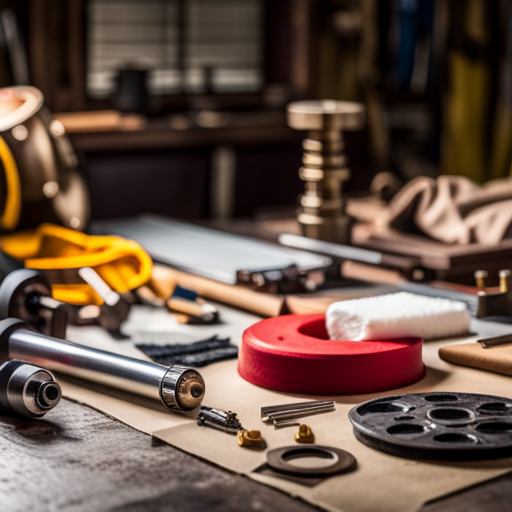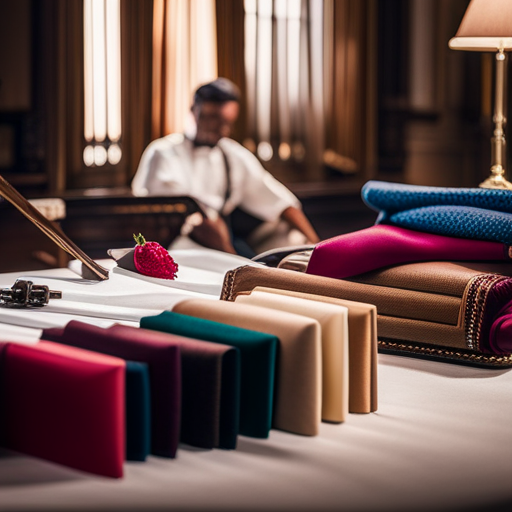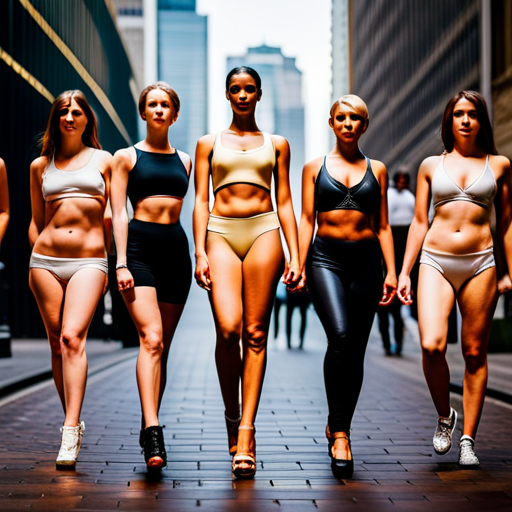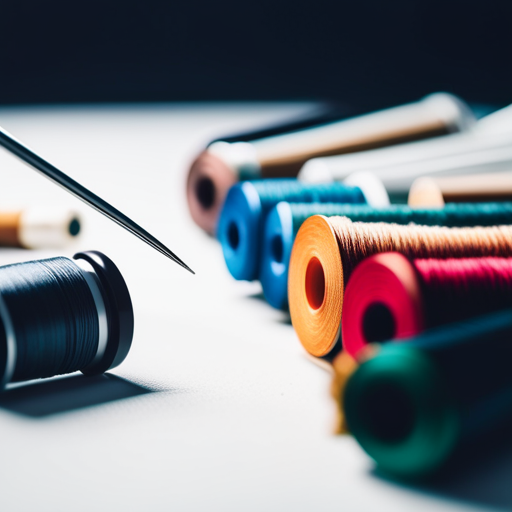Beginner’s Guide to Sewing Techniques for Costumes

Unleash your creative potential and embark on a transformative journey into the world of costume sewing.
Dive into a comprehensive beginner’s guide that will equip you with the fundamental techniques and skills to bring your costume creations to life.
From mastering essential hand stitches to navigating the intricacies of fabric types, this article will serve as your indispensable companion in elevating your sewing prowess.
Let’s begin this exhilarating adventure and unleash the seamstress within.
Essential Sewing Tools
The essential sewing tools for costume making include a sewing machine, fabric scissors, pins, and a seam ripper.
When it comes to cutting tools, a good pair of fabric scissors is indispensable for precise and clean cuts. It’s important to invest in high-quality fabric scissors to ensure smooth and accurate cutting, which is crucial for creating professional-looking costumes. Additionally, a rotary cutter and cutting mat can be beneficial for cutting straight lines and large pieces of fabric with ease.
Pattern making is another vital aspect of costume creation. Essential tools for pattern making include pattern paper, a clear ruler, and a French curve. Pattern paper allows for tracing and creating custom patterns, while a clear ruler and French curve aid in drawing and modifying pattern lines accurately.
Having these essential tools for cutting and pattern making is crucial for anyone venturing into costume making. They not only contribute to the overall quality of the finished costume but also make the sewing process more efficient and enjoyable.
Understanding Fabric Types
Understanding the different types of fabric is essential for costume making, as it directly impacts the drape, structure, and overall look of the finished garment. When choosing the right fabric for a costume, it’s important to consider various fabric properties such as weight, stretch, texture, and weave. Each fabric type has its own unique characteristics and knowing how to select the appropriate one for a specific costume can greatly enhance the final result.
To help you understand the different fabric types and their properties, consider the following table:
| Fabric Type | Properties |
|---|---|
| Cotton | Breathable, easy to dye |
| Silk | Luxurious, drapes well |
| Wool | Warm, durable |
| Polyester | Wrinkle-resistant, durable |
| Satin | Smooth, shiny |
| Velvet | Soft, luxurious |
Choosing the right fabric involves considering the design of the costume, the character it represents, and the practical aspects such as comfort and movement. By understanding fabric types and their properties, you can make informed decisions when selecting the most suitable fabric for your costume projects.
Basic Hand Stitches
Fabric manipulation through hand stitches is an essential skill for costume construction. Mastering basic hand stitches is crucial for creating professional-looking costumes. Two fundamental hand stitches that every beginner should learn are the running stitch and the backstitch. These stitches are versatile and can be used for various costume construction purposes.
Running Stitch
- Simple yet effective
- Ideal for gathering fabric
- Creates a delicate and subtle finish
Backstitch
- Strong and durable
- Suitable for seams that require extra reinforcement
- Provides a neat and polished appearance
Learning and practicing these basic hand stitches will lay a solid foundation for more advanced sewing techniques. By mastering the running stitch and backstitch, beginners can gain confidence in their ability to manipulate fabric and create well-constructed costumes. These stitches are the building blocks of hand sewing and are essential for any costume-making endeavor.
Machine Sewing Basics
Beginners should familiarize themselves with the basic operation of a sewing machine to understand its potential for costume construction. When using a sewing machine, it’s essential to understand thread tension and how to troubleshoot any issues that may arise. Proper thread tension ensures that the stitches are balanced and neat. If the tension is too tight, the fabric may pucker, and if it’s too loose, the stitches will be loopy. Beginners should consult the sewing machine manual to adjust the thread tension according to the fabric being used.
Another important aspect of machine sewing is stitch length adjustment. Stitch length determines how far apart the stitches are from each other. For most costume construction, a medium stitch length is suitable. However, for delicate fabrics, a shorter stitch length may be necessary to prevent the fabric from fraying. Conversely, a longer stitch length is appropriate for basting or gathering fabric. Beginners should practice adjusting the stitch length on scrap fabric to understand its impact on different materials.
Mastering these machine sewing basics will provide a strong foundation for creating well-constructed costumes.
Finishing Techniques
After mastering machine sewing basics, costume creators can enhance the quality and appearance of their creations through the application of various finishing techniques. Finishing techniques are essential for creating professional-looking costumes.
Here are some key finishing techniques to consider:
-
Hemming methods and seam finishing
-
Blind hemming: This technique creates a nearly invisible hem for a clean and polished look.
-
Overcasting: Overcasting is used to prevent fabric edges from fraying and provides a neat and durable finish to seams.
-
Edge treatments and embellishment techniques
-
Piping: Adding piping to edges can give a costume a more structured and decorative finish.
-
Appliqué: This technique involves attaching decorative fabric shapes onto the base fabric to add dimension and visual interest to the costume.
These finishing techniques not only contribute to the overall aesthetic appeal of the costume but also ensure that the garment is durable and well-constructed. By mastering these techniques, costume creators can elevate the quality of their work and bring their creative visions to life.
Frequently Asked Questions
What Are Some Tips for Sewing Costumes With Intricate Details or Embellishments?
When sewing costumes with intricate details or embellishments, consider using techniques like hand-stitching for delicate details, adding trims or appliques, and altering patterns for a customized fit. Sewing stretchy fabrics may require a walking foot or stretch needle.
How Can I Alter a Sewing Pattern to Fit a Specific Body Shape or Size?
When altering a sewing pattern for a custom fit, it’s crucial to take accurate body measurements. Understanding pattern adjustments and utilizing techniques such as grading between sizes or creating darts ensures a precise and flattering fit for any body shape or size.
Are There Any Special Techniques for Sewing Stretchy or Unusual Fabrics Often Used in Costume Making?
Sewing stretchy fabrics and manipulating unusual textiles in costume making require specialized techniques. Working with these materials demands precision, patience, and a keen understanding of fabric behavior. Mastery of these skills ensures professional-grade costume construction.
What Are Some Creative Ways to Add Texture and Dimension to Costume Designs Through Sewing Techniques?
When adding texture and dimension to costume designs, using textured fabrics like velvet or faux fur can create visual interest. Additionally, incorporating embroidery techniques such as appliqué or raised embroidery can further enhance the overall aesthetic.
Can You Provide Some Guidance on Creating and Sewing Costume Accessories, Such as Hats, Capes, or Armor Pieces?
When creating accessories for costumes, such as hats, capes, or armor pieces, it’s essential to focus on precision in sewing. Customizing patterns and adding embellishments can elevate the final look, ensuring attention to detail and quality.
Conclusion
In conclusion, mastering the art of sewing techniques for costumes requires patience, precision, and dedication.
Just like the careful stitching of a costume, the process of learning these techniques is a labor of love.
By understanding the essential tools, fabric types, hand stitches, machine sewing basics, and finishing techniques, one can embark on a creative journey of crafting beautiful costumes with skill and artistry.

Rufus Whitver is a passionate costume artisan and the creative mind behind layuo.com. With a keen eye for detail and a flair for imaginative design, Rufus brings characters to life through the art of costume making. His expertise encompasses a wide range of styles, from historical recreations to fantastical creations. Through layuo.com, Rufus shares insights, tutorials, and a portfolio showcasing his exceptional craftsmanship, inspiring fellow enthusiasts to embark on their own journey into the world of stunning costumes.





